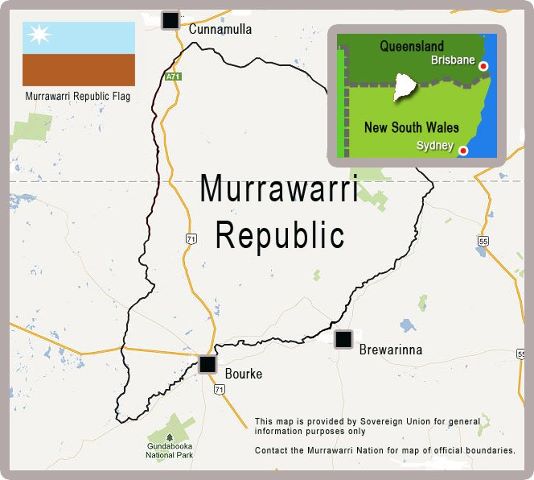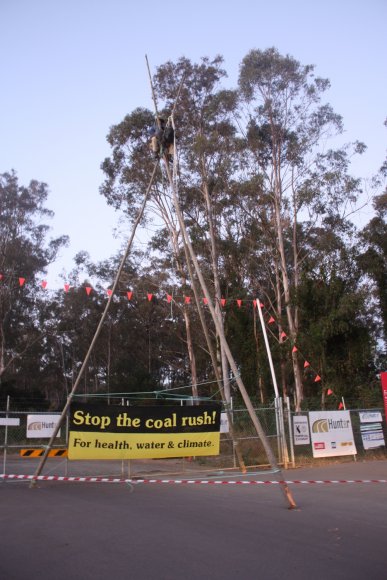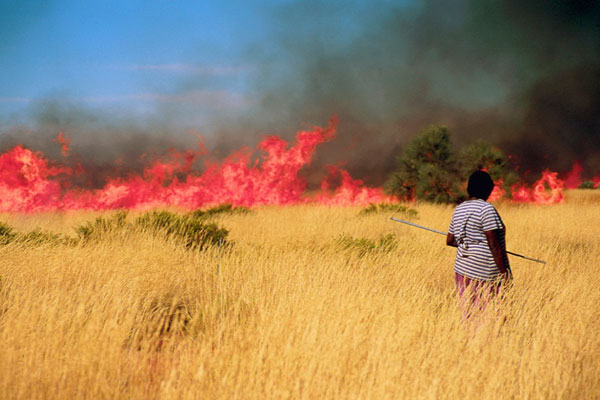
by Deep Green Resistance News Service | Aug 30, 2013 | Climate Change, Protests & Symbolic Acts
By Sarah Moles / Generation Alpha
Seven environmental activists today stole a ‘Carbon Bomb’ from the offices of transport company Aurizon (link www.aurizon.com.au) in Brisbane, Australia. The action signified the launch of their shop front hunger strike, pressuring Aurizon to withdraw planned capital from the largest coal complex in the world, planned for the Galilee Basin in their state of Queensland. Burning the coal from this complex is forecast to release over 700 million tons of carbon pollution each year, more than the total emissions Australia, the UK or Canada.
The hunger strike is part of the Over Our Dead Bodies (link www.OverOurDeadBodies.net) campaign, run by 40,000-strong Generation Alpha (link www.facebook.com/GenerationAlpha). Campaign coordinator Ben Pennings told the gathering media:
We’re here because Aurizon plan to bail out debt-ridden Indian company GVK, allowing them to dig up the first 3 coal mines in the Galilee Basin. Mining the Galilee is like setting off a bomb. This amount of carbon pollution is a deadly catastrophe, an environmental crime. So we’ve taken this carbon bomb from Aurizon to symbolize our intentions to stop them.
The campaign is designed to provide unique financial pressure on Aurizon, a rail freight company that specializes in coal. Activists in Australia but also internationally are committing to actions on the campaign website (link www.OverOurDeadBodies.net) that will cost Aurizon significant time and money. These include direct action and civil disobedience aimed at delaying infrastructure, hampering day-to-day operations and even targeting the company’s CEO and board members. Mr. Pennings said:
Aurizon have been ignoring the legitimate concerns of the environment movement for too long. So activists around the country are getting ready for direct action, to make the precarious finances of this complex even more so. Governments aren’t protecting our future, so we will.
The activists included former Australian Senator Andrew Bartlett (link http://en.wikipedia.org/wiki/Andrew_Bartlett). Andrew expressed his frustration with the lack of political engagement on climate change, saying:
We will be on a public hunger strike from today, engaging community members to understand that we can’t have the biggest coal complex on the planet, we can’t ignite this carbon bomb, and still avoid catastrophic climate change. We don’t want short-term mining projects that destroy communities and the environment. We want renewable power and long-term sustainable industries integrated into our communities.
For more on the Over Our Dead Bodies campaign, see http://www.OverOurDeadBodies.net
For the Hunger Strikers blog, see http://www.OverOurDeadBodies.net/blog
Generation Alpha’s Facebook page: http://www.facebook.com/GenerationAlpha

by Deep Green Resistance News Service | May 12, 2013 | Indigenous Autonomy
By Special Broadcasting Service
The Murrawarri Republic may be the world’s newest country, but for locals it’s been around for tens of thousands of years.
The Republic’s boundaries cross over northern New South Wales and Queensland – covering about 81,000 square kilometres.
Key leaders including Fred Hooper say the push for independence follows many frustrating years of inaction and broken promises.
Clan groups say the Queen of England, the Prime Minister and the Premiers of Queensland and New South Wales have been put on notice and given 21 days to respond to the declaration.
They say they will also be asking the UN to formally recognise their republic.
“You know according to our laws and customs, she (the Queen of England) does not now have any say over our country,” says Fred Hooper from the People’s Council of the Murrawarri Republic People’s council of the Murrawarri Republic.
“And we’ve also asked her to produce a number of documents. We have asked her to produce a treaty.”
The Murrawarri Tribe has its own constitution and bill of rights.
Fred Hooper says the new country will be inclusive and is offering non-Murrawarri people incentives, including citizenship and tax concessions.
“Certainly what we’re saying at the moment it is the status quo…People will maintain their land.”
The sovereign union camapaign says the declaration has now taken a step forward.
Michael Anderson believes it will spark a new wave of declarations similar to Murrawarri.
“The first flame has been lit, it’s now burning. The flames will spread right throughout this country. And there’s nothing Australia can do about it.”
The Murrawarri’s Council has been set up to look at a transition into the republic, including tribal law structures, industry and civil defence.
From Special Broadcasting Service: http://www.sbs.com.au/news/article/1765174/Murrawarri-people-declare-Aboriginal-sovereignty

by Deep Green Resistance News Service | Sep 5, 2012 | Mining & Drilling, Obstruction & Occupation
By Rising Tide Australia
Activists entered the Hunter 8 Alliance compound at Rutherford before dawn today, erecting a wooden tripod to block access to the site, which is part of a Federally funded project to increase coal haulage capacity in the Hunter Valley. Activist Ned Haughton scaled the 10 metre high structure, where he remained for the next five and a half hours. Haughton has now been arrested, and will be charged with obstruction.
Steve Phillips, spokesperson for protest organisers Rising Tide, said: “This railway construction project is designed purely for the benefit of coal corporations, yet it is being paid for with taxpayers money.”
“Why are taxpayers dollars being handed over to rich mining corporations, in order to prop up a polluting industry that is destroying human health and the environment?”
“There is a coal rush under way in NSW, and public health, waterways, ecosystems, and the global climate are under assault. Massive coal mine projects, coal haulage projects, and coal port projects are in the pipeline. If all these projects go ahead, the consequences will be devastating.”
Today’s protest follows two consecutive days of community direct action against the Boggabri mine in the Gunnedah Basin – the coal industry’s “new frontier”. A major expansion of the Boggabri coal mine was approved by the NSW Government in July despite huge ecological impacts and overwhelming community opposition.
“We call on State and Federal Governments to abandon their infatuation with mining companies, and their addiction to fossil fuels. It’s time to take a stand and stop this coal rush before it’s too late.”
Key facts.
- The Maitland to Minimbah Third Track project is being constructed by Hunter 8 Alliance, which is a consortium of engineering company GHD, construction company John Holland, and the Federally owned Australian Rail Track Corporation.
- The objective of the project is to lift coal haulage capacity on the Hunter rail corridor to 200 million tonnes per annum. It includes construction of 23km of new rail track, and reconditioning of 9km of existing track.
- The Federal Government granted $114 million, through the ARTC, to the project.
From Rising Tide Australia

by Deep Green Resistance News Service | Jul 14, 2012 | Listening to the Land
By Max McClure / Stanford University
Western Australia’s Martu people set small fires as a matter of course while hunting lizards. But the technique may also buffer the landscape against two extremes – overgrown brush and widespread lightning fires – that hurt Australia’s endangered small mammals.
When species start disappearing, it usually makes sense to blame it on the arrival of humans. But in the case of Western Australia’s declining small-mammal populations, the opposite may be true.
The Aboriginal Martu people of Western Australia have traditionally set small fires while foraging, leaving a patchwork landscape that proves a perfect environment for bilbies, wallabies, possums and other threatened mammals.
Stanford anthropologists have discovered that when these controlled burns cease, the desert rapidly becomes overgrown – and a single lightning strike can send wildfires tearing through hundreds of square miles of tinder-dry mammal habitat.
The paper, authored by Stanford anthropology Associate Professor Rebecca Bliege Bird, senior research scientist Douglas Bird, postdoctoral scholar Brian Codding and undergraduate Peter Kauhanen, appeared recently in the journal Proceedings of the National Academy of Sciences.
Hunting with the Martu
Martu Native Title, deep in Australia’s Western Desert, contains some of the most remote human settlements in the world. Parnngurr, a Martu community with a population of around 80, is located more than 200 miles from the nearest mining outpost.
Making the most of the harsh, arid landscape’s resources, the Aboriginal Australians hunt bustard, emu and kangaroo and collect a wide variety of fruits, tubers and seeds. But their most important resource is the sand goanna – a 4-foot long burrowing lizard that accounts for nearly 40 percent of all foraged calories.
The goanna hunt likely hasn’t changed in thousands of years. In winter, when the lizards are hibernating, groups of women head out from the camps and set fire to patches of the spinifex grass covering den entrances.
Once the brush has been cleared, the woman who sets the fire has first rights to dig out any goanna burrows she finds in the fire scar.
The practice is so ingrained in Martu culture that the Martu language has words for every stage of plant growth following a fire, ranging from nyurnma – a fresh fire scar – to kunarka – a landscape overgrown with spinifex.
“If you’re out hunting with Martu, it involves fire all the time,” said Douglas Bird. “You can’t understand any of their values without factoring in the fundamental role of fire.”
Comparing scars
The Martu were cleared from their lands in the mid-1960s to make way for the British government’s Blue Streak missile tests. Until the people won the official title to their territory again in 2002, an Alabama-sized portion of the Western Desert that they had previously managed saw no controlled fires.
Without human intervention, El Niño-driven monsoons had allowed dense spinifex to spring up in some areas and sprawling lightning-caused fire scars to appear in others.
“You ask the Martu people, and they explain, ‘We left, and the fire regime broke down,'” Douglas Bird said.
Now, 10 years after the Martu’s reinstatement of traditional hunting practices across their territory, the researchers compared a decade’s worth of fire scars in hunting grounds to land without an Aboriginal Australian presence.
The differences were stark. Where Martu women had hunted for goanna, the fire scars were smaller and more clustered, and there was a greater variety of ground cover.
Outside these areas, lightning strikes had burnt a small number of enormous scars, often larger than 10,000 hectares in size.
“Without the Martu, it’s very much like what we have in California,” said Rebecca Bliege Bird. “The desert is covered with a large, contiguous set of fuels.”
The burning also seemed to buffer against major seasonal changes – spreading fires throughout the year, rather than concentrating them during periods of extreme drought.
Managing for mammals
Evidence suggests that the lightning-style landscape is no good for small mammals. Thick brush is difficult to travel through – spinifex is tipped with painful silica points – and large fire scars mean few resources and more exposure to predation.
Australia’s mammal populations are disappearing faster than anywhere else in the world, and there’s reason to believe that the decline coincided with the collapse of Martu fire regimes.
“Presumably the same resources have been used for at least 5,000 years,” said Douglas Bird. “That’s plenty of time to get strong coupled interactions between humans and other mammals.”
Alternately, the researchers suggest, there is evidence that Australia’s climate variability was less extreme before humans arrived. Aboriginal peoples’ burning practices may have recreated the conditions mammals had originally evolved in.
“It challenges a bias that a lot of ecologists have,” said Rebecca Bliege Bird, “which is that all human impacts are negative.”
Western Australian Environment and Conservation officials have taken note of Martu strategies and currently conduct extensive prescribed burns across Western Australia, but official resistance to hunting and gathering remains.
“The government would rather come up with an interventionist policy than support these traditional processes that provide the same services,” Rebecca Bliege Bird said.
From Stanford University News: http://news.stanford.edu/news/2012/july/australia-hunting-fire-071212.html
by Deep Green Resistance News Service | Jun 5, 2012 | Indigenous Autonomy
By Ahni / Intercontinental Cry
There was a major victory this week in the struggle to protect the Koongarra uranium deposit in Australia’s Northern Territory.
The Northern Land Council, which represents native title claimants in the Arnhem Land region of Northern Territory, announced its decision to extend the boundaries of the world-heritage-listed Kakadu National Park to include the 1,200 hectare uranium deposit.
When the National Park was founded in 1979, the Australian government decided to leave Koongarra out, clearly recognizing the potential market value of the deposit. Located in the heart of Kakadu, the deposit is estimated to hold 14,540 tonnes of uranium ore worth approximately $5 billion.
In 1995, the Koongarra deposit was acquired by the French company AREVA, who has tried several times over the years to access the deposit. Fortunately, they have been blocked each and every time by traditional owners.
AREVA’s last big effort focused on whetting the appetite of the current Custodian of Koongarra and the sole survivor of the Djok clan (Gundjeihmi), Mr. Jeffrey Lee.
In 2007, the company told Mr. Lee–who was born the same year the massive uranium deposit was identified, in 1971–that he could be one of the richest men in the world. All he had to do was say “Yes.”
He said “No.”
Rather than sacrifice the land, Mr. Lee decided to speak out against uranium mining and began his effort to bring Koongarra into Kakadu Park, where, he said at the time, “it will be protected and safe forever”.
More recently, in 2011, the French company tried to stop UNESCO from inscribing Koongarra on the World Heritage List. The effort backfired. On June 27, 2011, the World Heritage Committee announced that it would redraw Kakadu’s borders to include Koongarra.
At this point, it’s still not clear if AREVA will try to reverse the Northern Land Council’s decision.
The Mirarr Peoples, meanwhile, continue to look for the day when the nearby Jabiluka uranium deposit will be similarly protected.
They too, have received offers to become billionaires and they too, have said no, that the uranium should remain undisturbed.
Last year, in the weeks leading up to UNESCO’s decision on Koongarra, Mirarr Elder Yvonne Margarula, in a letter to UN Secretary-General Ban ki-Moon, stated,
For many thousands of years we Aboriginal people of Kakadu have respected sacred sites where special and dangerous power resides. We call these places and this power Ojang. There is Ojang associated with both the Ranger mine area and the site of the proposed Jabiluka mine. We believe and have always believed that when this Ojang is disturbed a great and dangerous power is unleashed upon the entire world. My father warned the Australian Government about this in the 1970s, but no one in positions of power listened to him. We hope that people such as yourself will listen, and act, today.
The respected Elder was lamenting the fact that her father’s warning became brutal truth soon after the T?hoku earthquake and tsunami on March 11, 2011. Indeed, uranium from the Ranger uranium mine–also excised from Kakadu Park–can be traced directly to Fukushima.
It’s the nature of Ojang. If left undisturbed, protected by surrounding minerals, it keeps to itself. But once it is exhumed, then it waits for an opportunity, whether it’s a tsunami or a careless gesture by some underpaid employee. It doesn’t matter what it is, Ojang will seize it. And the consequences will be dire.
It must be left in the ground.
From Intercontinental Cry: http://intercontinentalcry.org/victory-the-struggle-to-protect-koongarra-uranium-is-finally-over/




